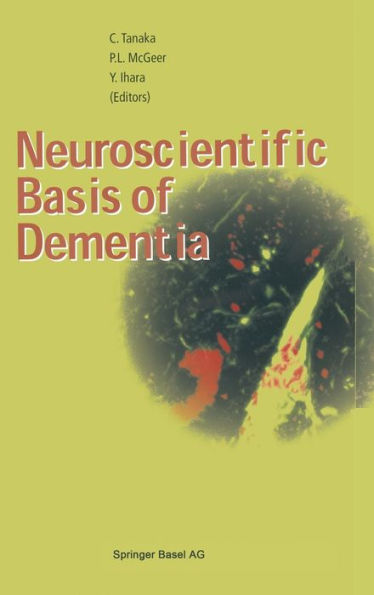5
1

Neuroscientific Basis of Dementia
318
by Chikako Tanaka (Editor), Patrick L. McGeer (Editor), Yasuo Ihara (Editor)
Chikako Tanaka

Neuroscientific Basis of Dementia
318
by Chikako Tanaka (Editor), Patrick L. McGeer (Editor), Yasuo Ihara (Editor)
Chikako Tanaka
Hardcover(2001 ed.)
$209.00
-
PICK UP IN STORECheck Availability at Nearby Stores
Available within 2 business hours
Related collections and offers
209.0
In Stock
Overview
In step with our growing lifespan, dementia is becoming a widespread handicap to the health and well-being of individuals and a burden on human society world-wide. The increasing prevalence of this tragic condition has stimulated an explosion of scientific research in the last ten years, which resulted in numerous profound insights and technical innovations. This timely volume presents both an overall and a detailed overview of the current worldwide knowledge about the neuroscientific basis of dementia. Leading authorities in their fields provide a far-reaching synthesis of all topics in dementia research, including pathogenesis of dementia, neuroimaging of the earliest alterations, potential biological and genetic markers for Alzheimer‘s Disease and new therapeutic strategies. Each chapter discusses clinical implications and areas of controversy, highlights the wide range of current and future therapeutic possibilities and indicates promising directions for further research...

Product Details
| ISBN-13: | 9783764362058 |
|---|---|
| Publisher: | Birkhauser Basel |
| Publication date: | 01/28/2001 |
| Edition description: | 2001 ed. |
| Pages: | 318 |
| Product dimensions: | 6.69(w) x 9.45(h) x (d) |
Table of Contents
Special lectures.- A tale of protein kinase C and membrane lipid signaling.- Complement, neuroinflammation and neuronal degeneration in Alzheimer disease.- Memory and its impairment.- Neurobiological mechanisms by which emotional arousal influences long-term memory formation.- Amygdalar damage and memory impairment in Alzheimer’s disease.- Neural substrate for spatial memory in the monkey hippocampus.- Involvement of CaM kinase II and mitogen-activated protein kinase in hippocampal long-term potentiation.- Pathogenesis of dementia — tau.- Transgenic mice overexpressing the shortest human tau isoform develop a progressive tauopathy.- Tau and neurodegenerative disease: genetics and pathogenetic mechanisms.- Tau mutations altering splicing of tau exon 10 in japanese frontotemporal dementia.- Amyotrophic lateral sclerosis/parkinsonism-dementia complex of the Kii peninsula of Japan (Kii ALS/PDC) may be a familial tauopathy. Epidemiological trends, clinical features, neuropathology and molecular genetics.- Senile dementia of the neurofibrillary tangle type (SD-NFT): a clinical, neuropathological and molecular genetic study.- The dual role of tau in cell polarisation and organelle trafficking.- Rearrangement of microtubule networks by tau bearing missense mutations.- Possible role of tau phosphorylation on ER membrane in Alzheimer pathology.- Pathogenesis of dementia — synuclein.- Pathogenesis of dementia: updating the role of synuclein pathology in sporadic and hereditary Alzheimer’s disease.-—-Synuclein/NACP and neurodegeneration.-—-Synuclein fibrillogenesis as target for drug development.- Pathogenesis of dementia — presenilin and amyloid.- Genetics of early-onset Alzheimer disease.- Lessons from presenilin domain analysis: endoproteolytic processing andenhanced Aβ42 production mediated by FAD-linked variants.- Amyloid and presenilins in the pathobiology of Alzheimer’s disease.- Role of presenilin in APP processing and Aβ production.- Impairment of response to ER stress in presenilin 1 mutant.- Mechanism of neuron death in Alzheimer’s disease.- Notch3 gene in CADASIL syndrome: mutation frequencies in Japanese and its expression and processing.- Etiological roles of Aβ and carboxyl terminal peptide fragments of amyloid precursor protein in Alzheimer disease.- Amyloid—-protein granules in glial cells in Alzheimer’s disease brain.- Amyloid— induces phosphorylation and translocation of MARCKS through tyrosine kinase-activated PKC-δ signaling pathway in microglia.- Amyloid—-protein accumulation in the human brain during aging.- Molecular mechanisms underlying initiation of amyloid fibril formation.- Catabolism of amyloid-β peptide in brain parenchyma.- Diagnosis and therapeutics of dementia.- Lessons in familial Alzheimer’s disease.- Biological markers for differential diagnosis of Alzheimer’s disease and related disorders.- Dietary factors and the risk of Alzheimer’s disease: a low fish consumption and a relative deficiency of—-3 polyunsaturated fatty acids.- Risk factors for dementia.- New therapeutic approaches to Alzheimer’s disease.From the B&N Reads Blog
Page 1 of
